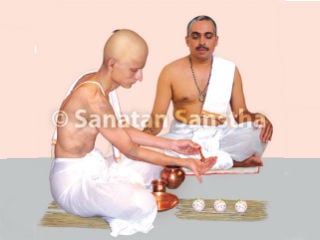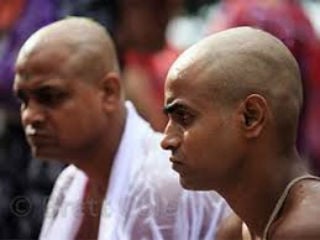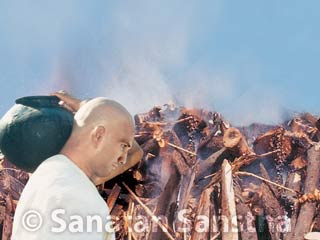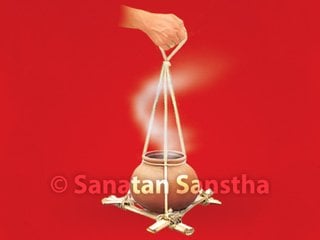If post-death rites are performed with faith and as prescribed by our Scriptures, then the linga-deha (Subtle-body) of the deceased person, without getting trapped in Bhulok (Earth region) or Martyalok (In the region of the dead), acquires a positive momentum and moves on to higher regions. Consequently, the possibility of the deceased person (Ancestor) tormenting the family members reduces. The possibility of such a linga-deha being enslaved by negative energies reduces too.
Once a person dies, his/her post-death rites are to be performed at the hands of a priest as mentioned in the Scriptures. Finding a priest with the knowledge of post-death rites is difficult in most places. What should be done under such circumstances is given ahead. There could be a difference in some of the acts, as also some difference depending on the region/traditions. Wherever you find such difference please consult your priest.
Material to be collected for the post-death rites
1. Bamboo
2. Coir rope (1 kilogram)
3. Two pitchers (earthen pots) – one small and other large
4. A white cloth sufficient to cover the dead body
5. Garland of tulsi (Holy basil) leaves
6. Mud from the base of a tulsi plant
7. 250 grams black sesame
8. 500 grams ghee (Clarified butter)
9. Darbha
10. 100 grams camphor
11. One match-box
12. Seven balls made from wet barley/rice flour
13. Pali-panchapatra (An offering spoon and a metal cup used in ritualistic worship)
14. Wooden logs of mango or jackfruit tree
15. A sickle
16. Bhasma/vibhuti (Holy ash)
17. Gopichandan
18. A piece of sandalwood
19. Cowdung cakes
20. One bowlful of panchagavya (A mixture of cow’s milk, curd, ghee, cow’s urine and cow dung)
21. Seven pieces of gold.
Initial rites to be performed after death
1. The person who performs the rite is called the karta. The eldest son of the deceased person is authorised to perform all the rites beginning from kindling the fire of the funeral pyre till the completion of entire rites.
2. Do not resort to crying aloud, beating the chest etc.
3. The household members should pray intermittently to Sri Dattatreya Deity for protection of the subtle-body of the deceased from the attacks of negative energies thus – ‘O Dattatreya, let your protective sheath be present around the linga-deha of … (mention the name of the deceased) always. We pray unto your Holy feet to impart progressively higher momentum to the deceased!’
4. Perform all subsequent rites accompanied while chanting ‘Sri Gurudev Datta’.
5. Before placing the dead body on the floor, smear the floor with cowdung. If it is not possible then sprinkle water containing either cowdung or vibhuti on the floor. Spread darbha on the floor and place on the darbha either a grass-mat, blanket, rug or a woollen blanket, and on it lay the person in a south-north direction with his/her feet facing the south.
6. Sprinkle bhasma or vibhuti around the body in an anti-clockwise direction, then pour some Gangajal in his/her mouth and place a tulsi leaf on it. Close the orifices of the nose and ears by placing a bunch of tulsi leaves in them
7. Light an earthen lamp / niranjan /samai (A metal lamp on a pedestal) with a single wick and place it on a mound of wet kneaded floor of wheat at some distance from the head of the dead body. The flame of the lamp should be facing the south direction. keep the lamp lit for the next ten days.
8. The karta should shave his head. The beard, moustache should also be shaved off and nails clipped. Retain a tuft of hair (Perform Kshourkarma), If the karta is elder to the deceased, then he should not shave his head. Women should not cut their hair or nails.
9. The karta should bathe and use new fabric to cover himself; for example – wearing a dhoti. Do not wear an uparna
10. Family members who are younger to the deceased, and other relatives should pay their obeisance to the dead body.
11. The dead body should then be taken to the front yard of the house and placed in an east-west direction with the feet facing the west. The karta should then bathe the corpse amidst loud chanting of ‘Sri Gurudev Datta’. Thereafter, bathe it with panchagavya. Apply gopichandan paste and bhasma /vibhuti to the dead body. Put a garland of tulsi leaves around the neck of the body.
12. After the bath, drape the dead body with new clothes (such as dhoti-shirt or a sari). If a virgin/unmarried woman has died, she should be dressed in a sari of any colour except white.
If a married woman has died, dress her in a new green sari. Put green glass bangles on her wrist and a garland of flowers in her hair. Apply Kumkum across her forehead. Other married women should apply haldi (Turmeric) and Kumkum to the dead married woman.
13. Cover the entire body (except the feet) with one single plain white cloth. Leave the feet uncovered. Expose the face. A portion of the cloth near the leg (one fourth the length of total cloth) is cut and used by the karta as uparna till the twelfth day. This cloth should not be misplaced. It should be placed near the pinḍas during the ritual of sapindikaran on the 12th day and be immersed in water along with the pinḍas.
Other important instructions
1. When the husband dies, the wife should separate the muhurtamaṇi and the black beads that are woven in a golden string and offer them to be kept along with the dead body of her husband on the pyre.
2. Do not keep the dead body for long. As far as possible, cremate the dead body during the day time.
3. All family members should constantly chant ‘Sri Gurudev Datta’ till the 13th day.
4. No one should unnecessarily touch the dead body.
5. If a boy or a girl aged less than 3 years old dies, they are buried and no religious rites are performed for them.

 Remember this while performing the rites of cremation during calamitous times!
Remember this while performing the rites of cremation during calamitous times! Performing ‘Palashvidhi’ as recommended by scriptures, if the final rites cannot be performed on the...
Performing ‘Palashvidhi’ as recommended by scriptures, if the final rites cannot be performed on the... Rituals to be performed on the same day after cremation
Rituals to be performed on the same day after cremation Rituals to be performed at home after death
Rituals to be performed at home after death Rituals of cremation
Rituals of cremation Preparation for the cremation and the funeral process
Preparation for the cremation and the funeral process